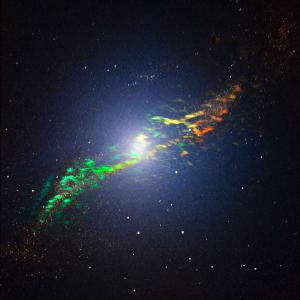Blog
Radio Galaxy
8 February 2014
A radio galaxy is a galaxy that emits large amounts of radio waves. They are powered by the galaxy’s supermassive black hole. When a supermassive black hole eats nearby gas, dust and stars, it is known as an active galactic nucleus (AGN). These active black holes have superheated material swirling around them in a circular disk, known as an accretion disk. The material in the accretion disk is swirling around the black hole in a tight circle, which means all the charged particles in the disk are being accelerated. When you accelerate charges, they give off radio waves along their direction of motion, known as synchrotron radiation. If you look at an AGN from a bit of an angle, you would see intense visible light from the superheated accretion disk, and depending on your angle you might (or might not) also see intense radio waves. If that’s the case, then it is a radio galaxy.
 ALMA (ESO/NAOJ/NRAO); ESO/Y. Beletsky
ALMA (ESO/NAOJ/NRAO); ESO/Y. BeletskyOne of the more famous radio galaxies is Centaurus A, which is one of the closest radio galaxies. Since its distance is only 10-15 million light years, we can actually get good observations. We know, for example, that its supermassive black hole is about 50 million solar masses, and that it is likely active due to a collision with a smaller galaxy.
Radio galaxies are also related to quasars. The term quasar comes from “quasi-stellar radio source,” as they were bright sources of radio energy that appeared point-like and thus star-like. We now know that quasars are also powered by active galactic nuclei, and radio loud quasars are distant radio galaxies.